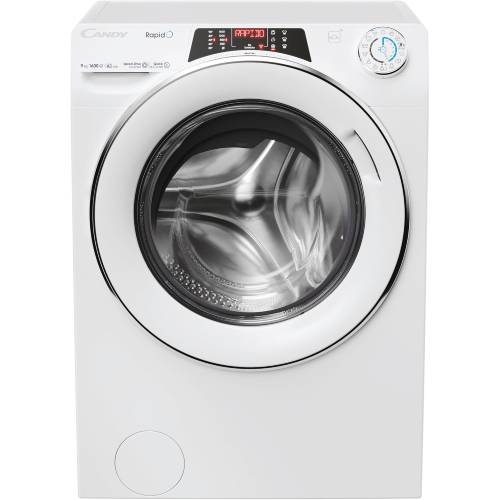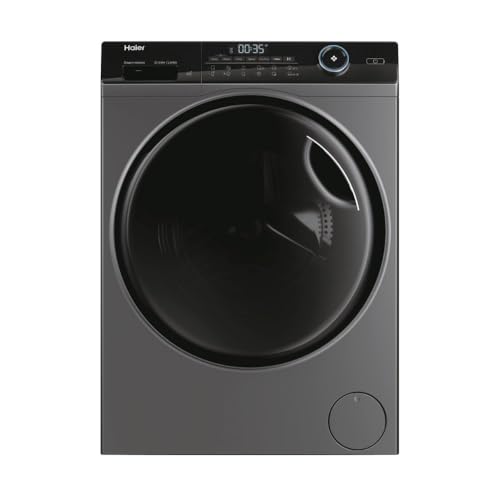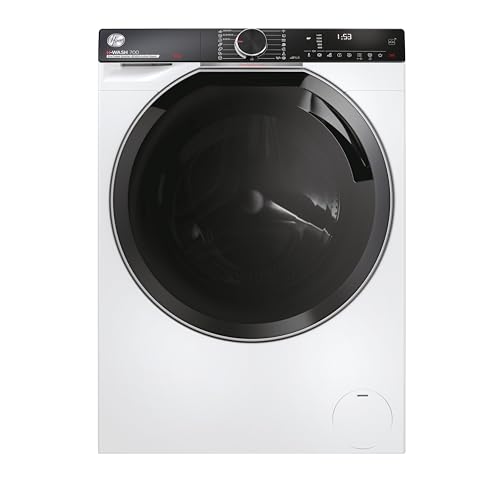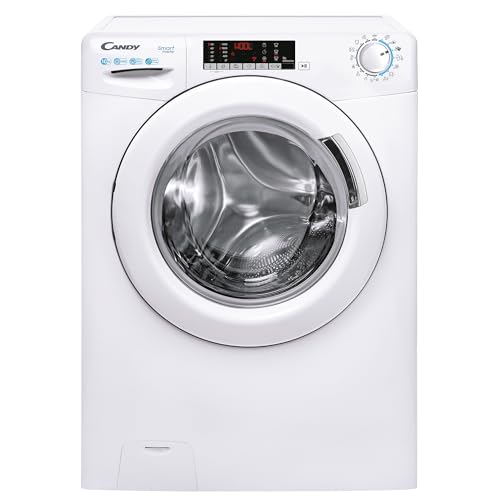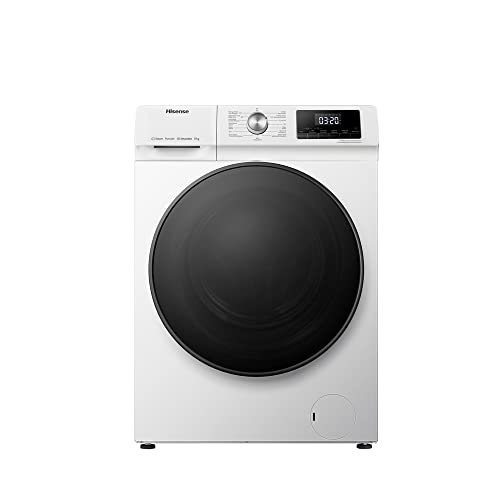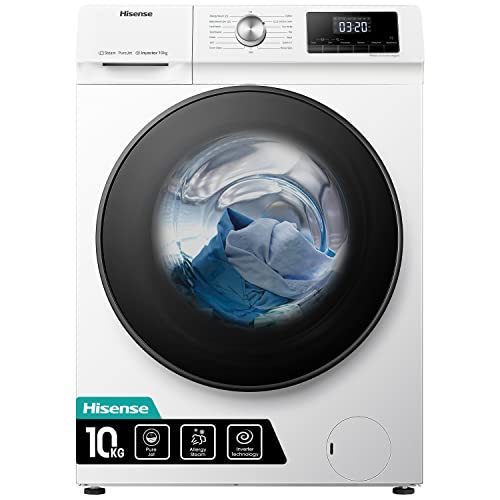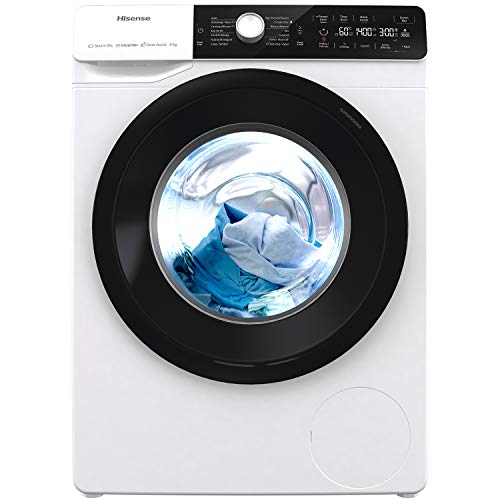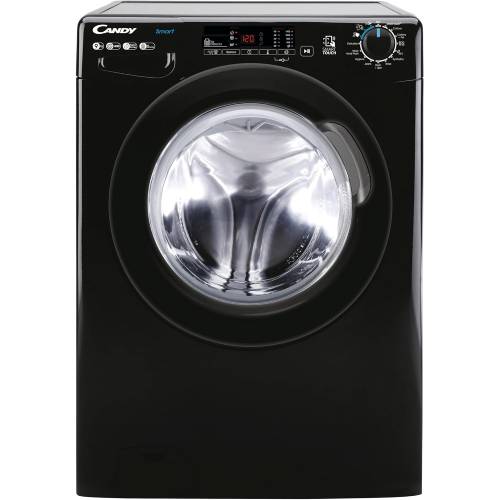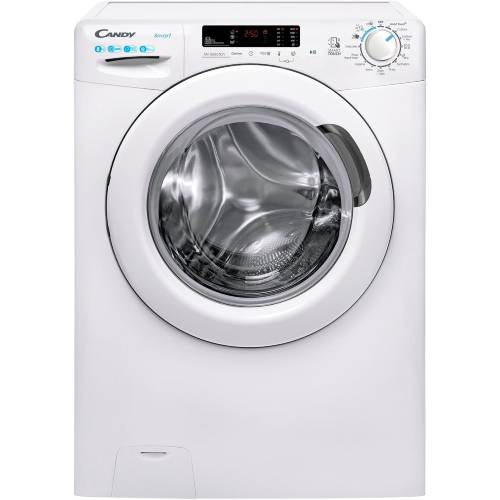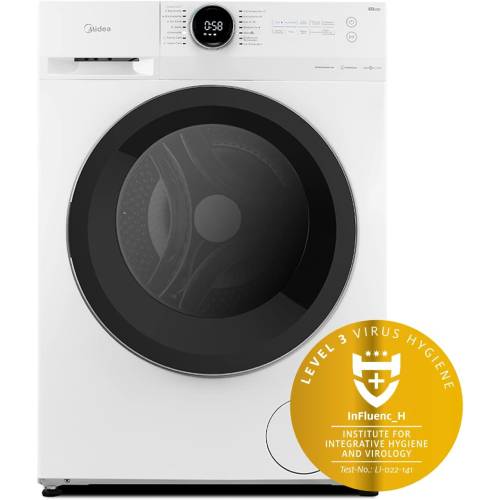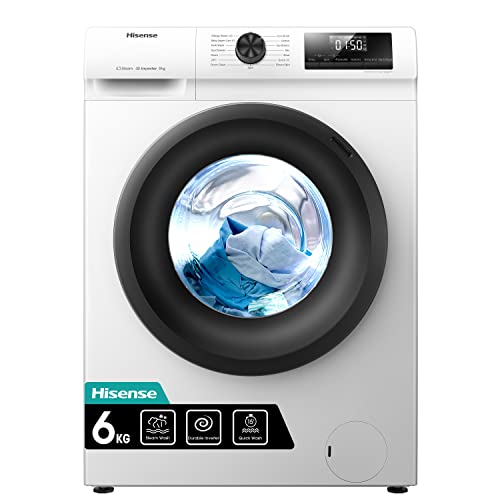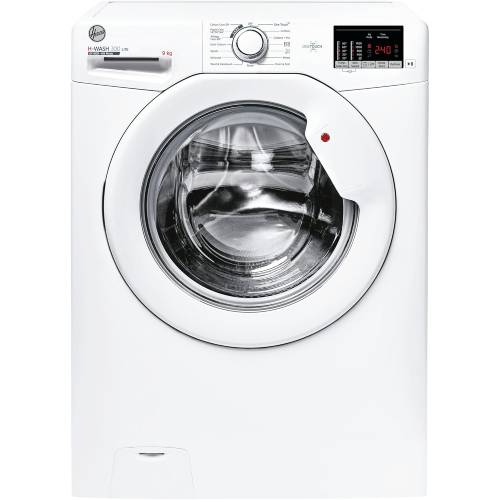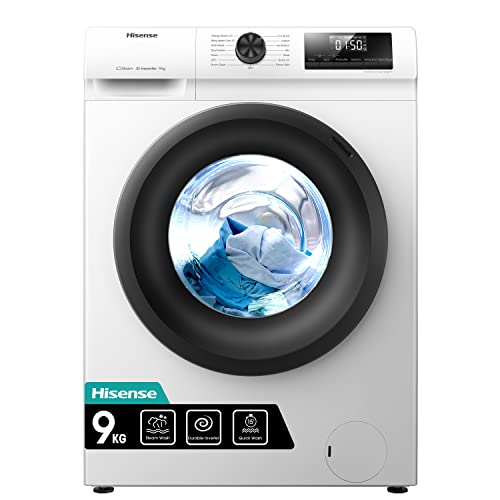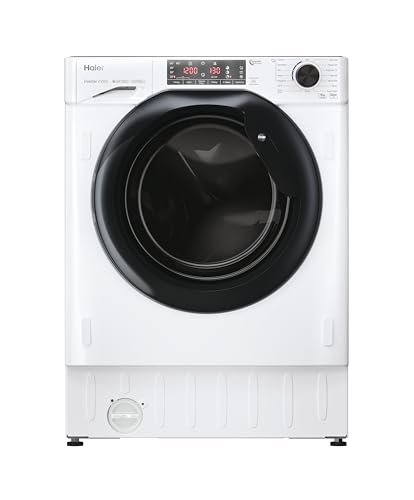How much does a cheap washing machine cost?
A washing machine is considered cheap if its price is below £400, a price range that includes about 36% of all washing machines on the market. A washing machine is defined as very affordable if it costs less than £350, a category that covers about 21% of all available models.
The chart below shows the price range distribution of washing machines.
[vertical-chart-26851916]
The following list includes the best cheap washing machines.
- Haier HW80-B14959S8U1 I-Pro Series 5 (Overall score: 7.79 points; Price: ~£300; Capacity: 8 kg)
- Candy Smart Inverter CS1410TXME (Overall score: 7.57 points; Price: ~£300; Capacity: 10 kg)
- Hisense WFQA1014EVJM QA Serie (Overall score: 7.4 points; Price: ~£320; Capacity: 10 kg)
The cheapest washing machines are as follows.
- SIA SWM6100W (~£200, 6 kg)
- Comfee CFE10EW60/W (~£200, 6 kg)
- Comfee CFE10W60 (~£210, 6 kg)
Are cheap washing machines worth it?
Cheap washing machines tend to have lower performance than non-cheap models, with an average overall score of 6.4 compared to 7.4 for more expensive models.
However, cheap washing machines excel in their price-to-quality ratio (7.4 points versus 6.8 points for non-cheap models). Therefore, if you are looking for good value for money, cheap washing machines are a valid choice. If budget is not a concern, check out our list of the best washing machines overall.
What are the main advantages of cheap washing machines?
The main advantages of cheap washing machines are as follows.
- Availability of slim and top-loading models: Cheap washing machines are available in various slim and top-loading designs.
- Better price-to-quality ratio: Cheap washing machines have a higher price-to-quality ratio compared to non-cheap models (7.4 versus 6.8 points).
- Greater popularity: The average popularity score of cheap washing machines is 6.1 points, higher than the 5.8 points of non-cheap machines.
- Good user ratings: Despite the lower cost, cheap washing machines receive ratings similar to more expensive models.
- Minimum spin speed of 400 rpm: Many cheap washing machines offer a minimum spin speed of 400 rpm, ideal for delicate garments.
- Washing functions: They often include features like prewash, extra rinse, anti-crease, anti-stain, or quick wash functions.
What are the main disadvantages of cheap washing machines?
The main disadvantages of cheap washing machines are as follows.
- Lower capacity: Cheap washing machines typically have a capacity of 7 kg or less and a drum volume of around 54 litres. The average washing machine on the market has an 8 kg capacity and a drum volume of 58 litres.
- Worse energy efficiency: Cheap washing machines consume about 10 kWh more per 100 cycles than the market average (65 kWh versus 55 kWh). Only 29% of cheap washing machines are rated in energy class A, while 39% of all washing machines fall into this category.
- Fewer inverter motors: Only about 48% of cheap washing machines feature an inverter motor, compared to 88% of non-cheap washing machines.
- Lower spin speeds: Only 41% of cheap washing machines reach a maximum spin speed of 1400 rpm.
- Noisier operation: Cheap washing machines are about 4 dB louder during spinning (76 dB versus 72 dB) and 5 dB louder during washing (58 dB versus 53 dB) compared to non-cheap models.
- Missing washing functions: Cheap washing machines often lack features like silent mode, Aqua+ function, or soak function.
- Absence of advanced features: Technologies such as steam, pre-mix technology, laundry detection systems, special drum design, Wi-Fi, artificial intelligence, automatic drawer cleaning, or automatic dosing systems are far less common in cheap washing machines compared to more expensive models.

What are the cheapest washing machine brands?
The cheapest washing machine brands are as follows.
- Daya (Average price: £250)
- SanGiorgio (Average price: £270)
- Indesit (Average price: £280)
The following brands have the most expensive washing machines.
- Miele (Average price: £1165)
- Siemens (Average price: £615)
- LG (Average price: £570)
The chart below ranks washing machine brands from cheapest to most expensive.
[horizontal-chart-11336555]
The following washing machine brands offer the best price-to-quality ratio.
- Cecotec (Average price-to-quality ratio: 7.6 points)
- Gorenje (Average price-to-quality ratio: 7.5 points)
- CHiQ (Average price-to-quality ratio: 7.4 points)
Note: We only considered the most popular brands with at least 10 products in our database.
What to consider when choosing the best cheap washing machine?
When selecting the best cheap washing machine, consider capacity, energy consumption per 100 cycles, water consumption per cycle, spin efficiency, noise levels during washing and spinning, motor type, washing programs, and available features.
Which type of washing machine is cheaper: front-loading or top-loading?
Top-loading washing machines cost an average of £40 less than front-loading washing machines (£350 versus £390). However, cheap front-loading washing machines are more efficient than top-loading ones and achieve a better overall score (6.4 compared to 5.8).
On the market, about 85% of cheap washing machines are front-loading, while only 15% are top-loading.
The distribution of cheap washing machines by load type is shown in the chart below.
[pie-chart-89444241]
Cheap front-loading washing machines have the following advantages over cheap top-loading machines.
- Better price-to-quality ratio: Cheap front-loading washing machines average 7.4 points in price-to-quality ratio, compared to 7 points for cheap top-loading machines.
- Availability of slim models: Many cheap front-loading washing machines come in slim designs.
- Higher capacity: Cheap front-loading washing machines have an average capacity of 8 kg and a drum volume of 55 L. Cheap top-loading machines have an average capacity of 7 kg and a drum volume of only 42 L.
- Lower energy consumption: Cheap front-loading washing machines consume about 11 kWh less per 100 cycles than cheap top-loading models (64 kWh versus 75 kWh).
- Better energy efficiency: 32% of cheap front-loading washing machines are rated energy class A, while no cheap top-loading machine achieves this rating.
- Higher spin speeds: 57% of cheap front-loading washing machines reach spin speeds of up to 1400 rpm, compared to 10% for top-loading models.
- Quieter operation: Cheap front-loading washing machines are about 2 dB quieter during spinning (76 dB versus 78 dB) and 5 dB quieter during washing (56 dB versus 61 dB).
- More inverter motors: 53% of cheap front-loading washing machines have inverter motors, compared to only 38% of cheap top-loading machines.
- Longer motor warranty: Cheap front-loading washing machines usually come with a 10-year motor warranty, while cheap top-loading machines only offer a 2-year warranty.
The cheapest front-loading washing machines are as follows.
- Comfee CFE10EW60/W (~£200, 6 kg)
- SIA SWM6100W (~£200, 6 kg)
- Comfee CFE10W60 (~£210, 6 kg)

The image above shows a cheap front-loading Hoover H-WASH 500 HWE4 37AMBS/1-S washing machine.
Cheap top-loading washing machines have the following advantages over front-loading models.
- Greater popularity: The average popularity score of cheap top-loading models is 7 points, compared to 6.1 points for front-loading models (partly due to the lower availability of top-loading models).
- More models achieve lower spin speeds: 81% of cheap top-loading washing machines reach a minimum spin speed of 400 rpm, compared to only 62% of cheap front-loading models.
- Faster ECO cycle: The ECO cycle of cheap top-loading washing machines is about 7 minutes shorter than that of cheap front-loading machines (208 minutes versus 215 minutes).
- Smaller size: Cheap top-loading washing machines take up about 21% less space than front-loading models (0.212 m³ versus 2.7 m³).
- Lighter weight: Cheap top-loading washing machines weigh about 9 kg less than cheap front-loading machines (56 kg versus 65 kg).
- Less prone to mould and easier to unload: Top-loading washing machines tend to be less prone to mould and are easier to unload than front-loading models.
The cheapest top-loading washing machines are listed below.
- Electrolux EW6T526C SensiCare 600 (~£350, 6 kg)
- Indesit BTW L50300 (~£370, 5 kg)

What is the capacity of cheap washing machines?
Cheap washing machines typically have a capacity ranging from 4 to 10 kg, with the most common capacities being 7 kg (27%) and 8 kg (30%). On average, a 7 kg washing machine costs around £330, an 8 kg model costs approximately £370, and a 9 kg model costs about £490. There is a moderate correlation (0.39) between capacity and price, indicating that cheaper washing machines tend to have smaller capacities than more expensive models. Washing machines with larger capacities are more expensive due to additional features they offer.
The chart below illustrates the distribution of capacities among cheap washing machines.
[pie-chart-68273310]
The best cheap washing machines with a 7 kg capacity are as follows.
- Midea MF200W70B/E (Overall score: 7.12 points; Price: ~£250)
- Midea MF10EW70BA (Overall score: 6.66 points; Price: ~£300)
- Bosch WAN28081GB Serie 4 (Overall score: 6.21 points; Price: ~£330)
The following list includes the best cheap washing machines with an 8 kg capacity.
- Haier HW80-B14959S8U1 I-Pro Series 5 (Overall score: 7.79 points; Price: ~£300)
- Candy Smart CS1482DW4 (Overall score: 7.15 points; Price: ~£250)
- Zanussi ZWF842C3PW (Overall score: 6.46 points; Price: ~£310)
Cheap washing machines occupy an average of 0.265 m³ of space, slightly less than the market average of 0.28 m³. Depths range between 38 and 65 cm, making various slim models suitable for smaller spaces.
What is the energy efficiency of cheap washing machines?
Cheap washing machines tend to have lower energy efficiency compared to more expensive models. Their energy classes range from A to G, with class D being the most common. Specifically, 29% of cheap washing machines belong to class A, 12% to class B, 15% to class C, 28% to class D, 8% to class E, 6% to class F, and some fall into class G. By contrast, across all washing machines on the market, the most common energy class is class A, accounting for 39%. This disparity is because cheap models often use less advanced technologies, reflected in lower energy savings.
The distribution of energy classes among cheap washing machines is shown in the chart below.
[pie-chart-35914135]
Energy consumption is closely tied to energy class. Class A washing machines consume less than 49 kWh per 100 cycles, while class B models consume less than 55 kWh. However, this correlation may vary slightly depending on the washing machine's capacity.
Cheap washing machines consume between 44 and 91 kWh per 100 cycles, with an average of about 65 kWh (10 kWh more than the market average). For those looking to reduce energy costs, cheap front-loading washing machines are a better choice, as they consume about 11 kWh less per 100 cycles than top-loading models.
When purchasing a washing machine, it's important to consider energy consumption. In the long term, a more expensive model with reduced consumption may be more cost-effective than a cheap model that consumes more energy. Although the initial cost is higher, the savings on energy bills could offset the price difference, making a more efficient model a better investment.
The most energy-efficient and budget-friendly washing machines are as follows.
- Midea MF10EW70BA (Energy consumption: 44 kWh/100 cycles per 100 cycles; Price: ~£300; Capacity: 7 kg)
- Haier HW80-B14959S8U1 I-Pro Series 5 (Energy consumption: 49 kWh/100 cycles per 100 cycles; Price: ~£300; Capacity: 8 kg)
- Midea MF10EW90BA (Energy consumption: 49 kWh/100 cycles per 100 cycles; Price: ~£300; Capacity: 9 kg)
The following washing machines with energy class A are the cheapest.
- Midea MF10EW90BA (Energy consumption: 49 kWh/100 cycles per 100 cycles; Price: ~£300; Capacity: 9 kg)
- Midea MF10EW70BA (Energy consumption: 44 kWh/100 cycles per 100 cycles; Price: ~£300; Capacity: 7 kg)
- Candy Smart Inverter CS1410TXME (Energy consumption: 51 kWh/100 cycles per 100 cycles; Price: ~£300; Capacity: 10 kg)
In terms of water consumption, cheap washing machines use between 30 and 52 litres per cycle, with an average of 45 litres (1 litre less than the market average). This water savings is mainly due to the smaller capacities of these models, as smaller washing machines tend to consume less water than larger ones.
What is the spin efficiency class of cheap washing machines?
Cheap washing machines fall into spin efficiency classes ranging from A to D, with class B being the most common (79%), followed by class C (19%). This classification indicates the washing machine's ability to remove water from clothes after spinning and is closely related to maximum spin speed.
The distribution of spin efficiency classes among cheap washing machines is shown in the chart below.
[pie-chart-54100678]
Cheap washing machines have a maximum spin speed ranging from 1000 to 1600 rpm. The most common speed is 1400 rpm (49%, 41%), followed by 1200 rpm (31%, 35%). In comparison, 60% of all washing machines on the market reach 1400 rpm. Higher spin speeds allow more water to be extracted from clothes, reducing drying times.
If you frequently wash delicate clothes, consider the washing machine's minimum spin speed. Delicate fabrics require lower speeds to prevent damage. Among cheap washing machines, the minimum speed ranges between 400 and 800 rpm, with about 65% of models capable of reaching a minimum speed of 400 rpm.
Are cheap washing machines noisy?
Cheap washing machines tend to be noisier than more expensive models. The noise level during spinning ranges between 66 dB and 81 dB, with an average of 76 dB. By contrast, non-cheap washing machines average around 72 dB, making cheap models approximately 4 dB louder. This difference is primarily due to the lack of technologies in cheaper models, such as load balancing systems, inverter motors, anti-vibration technology, and higher-quality insulating materials.
Most cheap washing machines fall into noise emission class B (48%), followed by class C (35%). Class A represents spin noise levels below 73 dB, class B covers levels between 73 and 76 dB, class C between 77 and 80 dB, and class D refers to levels above 80 dB.
The chart below illustrates the distribution of spin noise levels among cheap washing machines.
[vertical-chart-30691972]
Regarding washing noise, cheap washing machines produce between 50 and 62 dB, with an average of 58 dB (about 5 dB more than more expensive models). While spin noise is more noticeable, washing noise levels are also worth considering.
How many washing programs do cheap washing machines have?
Cheap washing machines typically include 8 to 20 washing programs and 1-2 quick cycles under an hour, a similar number to more expensive models. There are no major differences in washing programs compared to pricier models.
Cheap washing machines stand out for specialized cycles like Shirts, Jeans, Duvets, Hygiene, Anti-Allergy, Outdoor/Sport, and washing functions such as prewash (82%), extra rinse (72%), anti-crease (52%), anti-stain (54%), or quick wash (24%). Very few include silent mode, Aqua+ function, or soak function.
When choosing a washing machine, consider the specific cycles and functions you will use or need most frequently.

The following list includes cheap washing machines with the highest number of washing programs.
- Cater-Wash CK8588 (16 washing programs, ~£250, 8 kg)
- Beko WTL74051B b100 (15 washing programs, ~£290, 7 kg)
- Candy Smart Inverter CS1410TXME (15 washing programs, ~£300, 10 kg)
What are the common features of cheap washing machines?
Cheap washing machines generally have 4 to 17 functions, with an average of about 3 fewer functions compared to non-cheap models (8 versus 11).
The number of features present in cheap washing machines is distributed as follows.
[vertical-chart-52857100]
The following features are less common in cheap washing machines compared to more expensive models.
- Steam technology (34% of cheap washing machines, compared to 68% of non-cheap washing machines): uses steam to enhance cleaning and reduce wrinkles during washing.
- Pre-mix technology (13% versus 30%): pre-mixes detergent and water for more even distribution in the laundry.
- Laundry detection system (85% versus 95%): automatically detects the load to optimize water and energy consumption.
- Special drum design (24% versus 56%): the drum is designed to treat fabrics more gently and improve washing effectiveness.
- AquaStop system (19% versus 36%): prevents water leaks by stopping the cycle to avoid damage.
- Wi-Fi (7% versus 30%): allows remote control and monitoring of the washing machine via an app.
- AI technology (<3% versus 17%): uses artificial intelligence algorithms to optimize washing cycles.
- Automatic drawer cleaning (5% versus 16%): automatically cleans the detergent drawer to prevent residue buildup.
- Automatic dosing system (<3% versus 16%): automatically adjusts the amount of detergent and softener used.
Additionally, only 48% of cheap washing machines feature an inverter motor, compared to 86% of non-cheap models.
When choosing a washing machine, also consider features such as foam control systems, load balancing systems, self-cleaning functions, or memory functions, which are common even in cheap models.
The following list includes cheap washing machines with the highest number of features.
- Candy Smart CS1482DW4 (17 features, ~£250, 8 kg)
- Candy Smart CS149TWBB4/1-80 (17 features, ~£290, 9 kg)
- Haier HW80-B14959S8U1 I-Pro Series 5 (17 features, ~£300, 8 kg)

